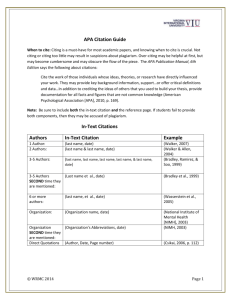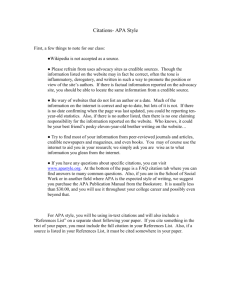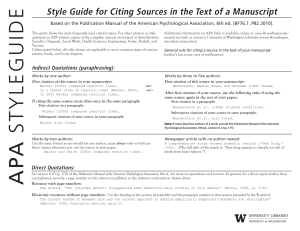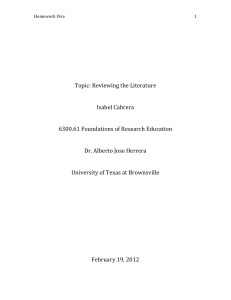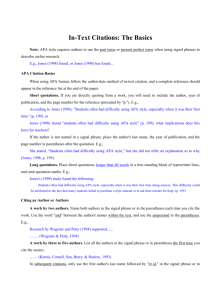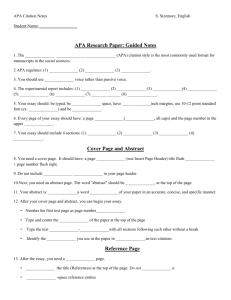Guidelines for Authors
advertisement
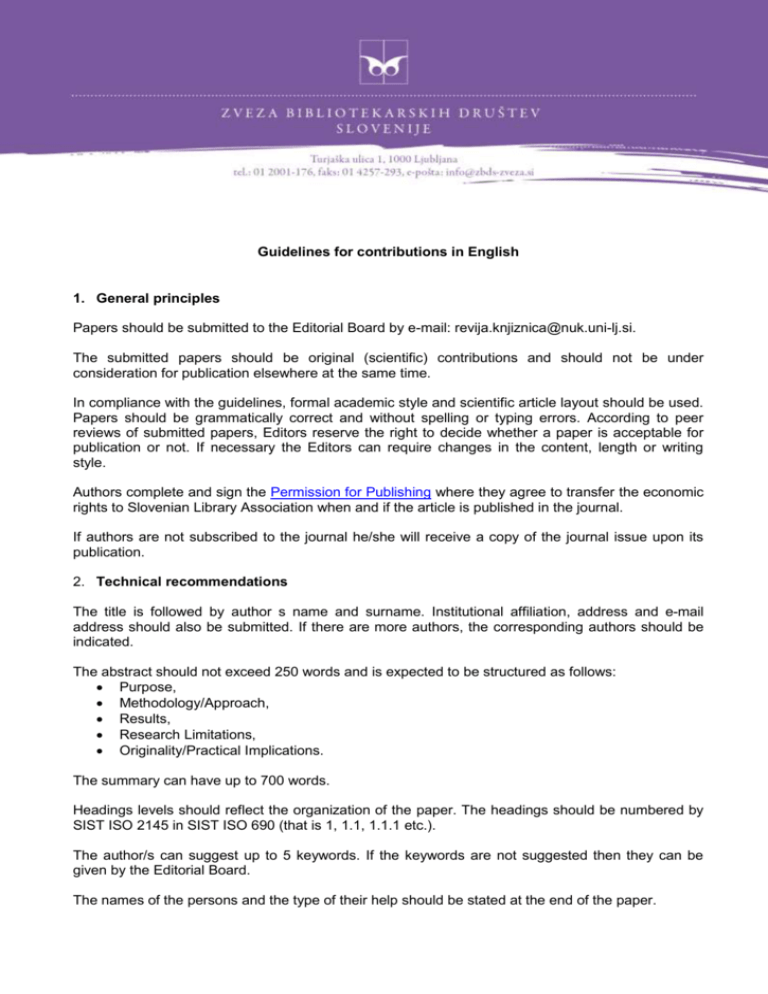
Guidelines for contributions in English 1. General principles Papers should be submitted to the Editorial Board by e-mail: revija.knjiznica@nuk.uni-lj.si. The submitted papers should be original (scientific) contributions and should not be under consideration for publication elsewhere at the same time. In compliance with the guidelines, formal academic style and scientific article layout should be used. Papers should be grammatically correct and without spelling or typing errors. According to peer reviews of submitted papers, Editors reserve the right to decide whether a paper is acceptable for publication or not. If necessary the Editors can require changes in the content, length or writing style. Authors complete and sign the Permission for Publishing where they agree to transfer the economic rights to Slovenian Library Association when and if the article is published in the journal. If authors are not subscribed to the journal he/she will receive a copy of the journal issue upon its publication. 2. Technical recommendations The title is followed by author s name and surname. Institutional affiliation, address and e-mail address should also be submitted. If there are more authors, the corresponding authors should be indicated. The abstract should not exceed 250 words and is expected to be structured as follows: Purpose, Methodology/Approach, Results, Research Limitations, Originality/Practical Implications. The summary can have up to 700 words. Headings levels should reflect the organization of the paper. The headings should be numbered by SIST ISO 2145 in SIST ISO 690 (that is 1, 1.1, 1.1.1 etc.). The author/s can suggest up to 5 keywords. If the keywords are not suggested then they can be given by the Editorial Board. The names of the persons and the type of their help should be stated at the end of the paper. All tables, figures and graphic presentations should be numbered and headed. They should be submitted in a separate file in high resolution for printing. Examples of figures: Picture 1: Book shelves in National and University Library (Source: National and University Library Archive) Table 1: Bibliography of the books on shelves1 Book: Year: Sh. No.: Book One 1810 NUK ZST 56 Book Two 1811 NUK ZST 57 All cited materials should have a note of acknowledgement (reference) to the original. It is recommended to use footnotes only for additional explanations and not for citing or reference listing. Citing should conform to APA (American Psychological Association) citation style. Citations should be placed in the text using the author-date citation system. If there are more than three authors, cite only the first one followed by the phrase “et al.” If you cite two or more works within the same parentheses, they should be separated by a semicolon. The citing in the text should be as follows: There were several studies on information retrieval (Smith, 1980; Johnson, 1982, 1990a, 1990b; Kovač, Benko & Mlinar, 1987; Mohorko et al., 1990). Among recent studies the one by Urbanija (1993) should be mentioned, but the opinion of Leight (1996, pp. 4-5) is even more interesting: »The modern librarians have more competencies.« Moreover, there were results published in older research (Line, 1979 as cited in Mihalič, 1984). The legal question was also raised (Act, 1982) and was described in a book The basic of librarianship (Banič, 1993). It is also stated in the international standard (ISO 11620, 1998) and on the Slovenian Library Association web site (http://www.zbdszveza.si). At the end references and resources should be listed in the alphabetical order according to the APA style. For every in-text citation there should be a full citation in the reference list and vice versa. If the author cites more than 10 information sources which are used as primary research data (annual plans and reports, statistical data etc.) they should be listed in a separate section of resources. If the 1 Source: NUK on-line catalogue COBISS/OPAC, V6.0. Retrieved 23. 7.2012 from: http://cobiss6.izum.si/scripts/cobiss?ukaz=BASE&bno=50001&id=1505242910475605. work has not been published yet it is recommended to use the phrase “in press”. All the authors used in the paper should be listed. Examples of references: Authored Book: Mitchell, T. R. & Larson, J. R., Jr. (1987). People in organizations: an introduction to organizational behaviour (3rd ed.). New York, NY: McGraw-Hill. Hurst, J. M., White, L. & Lines, L. M. (in press). Basic facts about the library systems. Cambridge, MA: Harvard University Press. Chapter in an Edited Book: Bjork, R. A. (1989). Retrieval inhibition as an adaptive mechanism in human memory. In H. L. Roediger III & F. I. M. Craik (Eds.), Varieties of memory & consciousness (pp. 309–330). Hillsdale, NJ: Erlbaum. Journal Article: Herbst-Damm, K. L. & Kulik, J. A. (2005). Volunteer support, marital status, and the survival times of terminally ill patients. Health psychology 24, (3-4), 225–229. Newspaper Article: Pelko, J. (1997, March 28). New libraries? The Washington post, 50, p. 11. Graduate, MA and PhD works: Vogrin, D. (1993). Reading habits. PhD work. Ljubljana: University of Ljubljana. Faculty of Arts. Electronic resource: Electronic reference formats recommended by the American Psychological Association. Washington, DC: American Psychological Association. Retrieved 3. 5. 2000 from: http//www.apa.org/journals/webref.html Legal and other documents: Library Act. (2006). Official Gazette of Republic Slovenia, no. 51 & no. 117. ISO 5963:1985, Documentation - Methods for examining documents, determining their subjects, and selecting indexing terms. (1985). Geneva: ISO.
